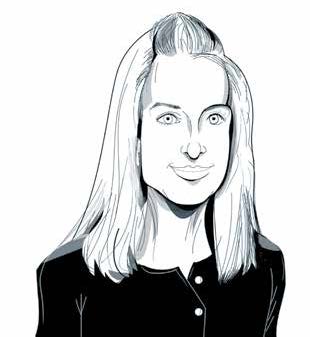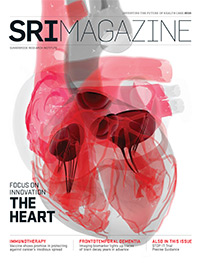Q&A
Dr. Clare Atzema
Dr. Clare Atzema is a scientist in the Tory Trauma Research Program at Sunnybrook Research Institute and an emergency physician at Sunnybrook, where she sees 15 to 30 patients in an eight-hour shift. She is also a scientist at the Institute for Clinical Evaluative Sciences (ICES) and an assistant professor at the University of Toronto. She spoke with Eleni Kanavas about her research.

Illustration: Antony Hare
What is the focus of your research?
I have two foci. One is atrial fibrillation (a common arrhythmia of the heart) and how we manage it in the emergency department, as well as after people leave—the continuity of care between the emergency department and primary care, for example.
The other focus is, more broadly, cardiovascular disease in the emergency department. Again, I’m focused on the continuity of care with primary care, particularly because we’re trying to help these patients avoid being admitted to hospital. If you’re going to avoid that high level of care and send these patients home, where potentially no one’s looking after them, then you need to have a system in place to ensure that they get timely follow-up care.
Right now, the patient is the system. We say, ‘Please make sure you see your family doctor within a week,’ and hope they pick up the phone. Sometimes we can call the family physician, but most people are in the emergency department after 5 p.m., when primary care is not open.
This “system” is especially important for the elderly and frail—they are the ones who are likely to have the most difficulty navigating the system, unless they have someone to advocate for them. They often aren’t good at advocating for themselves. It’s those patients in particular who I’m focused on, to try and establish some system of care such that we know they’ll get seen after discharge from the ER. We know that with an aging population there will be a lot more ER visits in the next few decades, and we don’t want to admit them all to hospital, but you can’t just send them home and say, ‘Hope that works out for you.’
![]()
Facts about emergency department visits (and one about access to family physicians)
- About 12 million people visit an emergency department (ED) in Canada each year, with the highest rates among the elderly.
- There were more than 57,000 visits to the Sunnybrook ED in 2013–2014.
- One in five Canadians visits an ED every year.
- Chest pain is the second most common reason for ED visits, behind abdominal pain.
- Minor trauma injuries such as cuts and head injuries are the most common diagnoses in the ED.
- 33% of Canadians wait six or more days to see their family doctors.
Over the years, have you seen progression in better patient outcomes?
I’ve done a study that shows that the number of afib [atrial fibrillation] patients in Ontario’s emergency departments has gone up by 30% between 2002 and 2010. If we continue to admit the same proportion of those patients that we admit now (about 40%), and we do that for every disease, then we are going to overwhelm the hospital, so we have to send more patients home.
But what actually happens after ER discharge is a problem. For example, we did a study on patients with a new diagnosis of atrial fibrillation, who are at increased risk of stroke and heart failure. Some emergency physicians start them on something, while others don’t, and we tell these patients to see their family doctor to continue the care we may have started.
We found that only 50% of these new patients with afib were being seen in Ontario by their primary care physician or a relevant physician [e.g., cardiologist] within seven days, which is the period within which the emergency doctors want them seen. By 30 days, 82% had been seen. So 18% with a new diagnosis of atrial fibrillation still had not seen anyone, which is disconcerting.
Why did you become an emergency doctor?
It’s a privilege to be offered that incredible trust, to be a part of someone’s life during that high acuity moment when they are showing up in the emergency department and giving you their complete trust.
Everyone works together, [that] is the other great thing about emergency. You’re surrounded by smart people—nurses, doctors and the staff I work with on a daily basis. It’s a can-do environment, because we’re all working toward helping the patient, and that is incredibly fortifying.
What are some ways to prevent emergency department visits?
In the winter, for shoveling snow, call someone, hire someone or get a snow blower.
I feel there aren’t that many ER visits that are not justified. The media talk a lot about patients who come to the ER who don’t need to be here, and I find that some of my patients apologize for coming, but you can’t diagnose what your chest pain is; that’s my job.
Not to mention that if they made it through what is sometimes a six-hour wait, then most people have a pretty good reason for being here. It might be nothing in the end, but it might have been something. That’s my job—to figure out which it is.
That’s unless you can see your family doctor right away (and that would be fine—if you have same-day access to your family physician). We need to ensure better access because as the Commonwealth [Fund] Study shows, we are pretty low down for being able to obtain an appointment in a timely way. [Canada ranked last of 11 advanced industrial countries on timeliness of care, for all levels of service.]
That said, there’s nothing like working over the holidays in emergency to make you really appreciate family physicians and all that they do. For example, influenza went around over the holidays, which caused a spike in ER visits: it makes you realize that what usually happens is those people do see their family doctor and then we don’t see them. But without those family doctors we are overflowing. There are no chairs left in the waiting room or beds to put patients in, and it’s standing room only.
I’d like to do a study showing that—to look at how we are completely hit [during the holidays]; the numbers are incredible, all because some of the family doctors are away. It makes me appreciate how much work they take off us normally.
Why is it important to examine the relationship between early care in the emergency department and outcomes in patients with cardiac illnesses?
Some of the things that we do in the emergency department are time dependent. We know that with heart attacks, for example, the sooner the better, in terms of patient outcomes; same with strokes.
However, while we do good work in the emergency department, and we fix the problem at hand, I suspect that for most patients what really matters is what happens after they leave the ER. Did they get to see the family doctor in a timely way? Did they get started on the evidence-based medications that we all know will help their disease?
Depending on what brought you to the ER, I feel that what happens after the visit is often more important than what happens to you in the emergency department.
Is most of your work provincial?
I generally only focus on Ontario, although I also examine Canada-wide data, and I have collaborated with other people. One example is a recent paper where we did a direct comparison of the proportion of visits to the ED for afib that result in hospitalization in Ontario versus the U.S. We discovered that 69% of the U.S. ED visits for afib end up in admission, whereas in Ontario it’s 37%. The big difference was in young patients [aged 18 to 64 years]; whereas we admit only about 26% of those people to hospital, in the U.S. it was around 63%.
What are some of the next steps in your research?
We need to mine the data on who gets follow-up care more extensively. As well, we assume that getting such care matters, and we have some longer-term studies that show that it does matter if you get seen in a timely way after you leave the emergency department, but we can’t say for sure whether or not seeing your family doctor within seven days has an impact on your mortality five years later, for example.
Is there anything else you’d like to add?
Don’t shovel snow if you are over 65 and have heart disease!
Atzema’s research is funded by the Canadian Institutes of Health Research and the Heart and Stroke Foundation of Canada.



